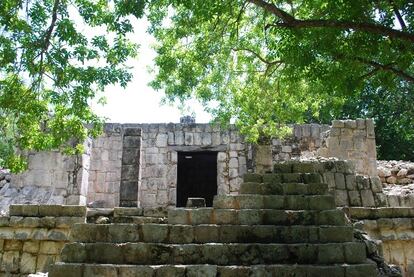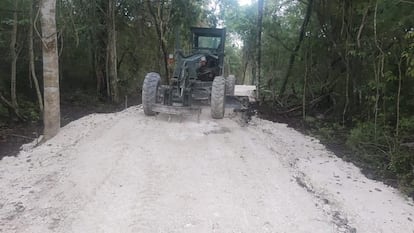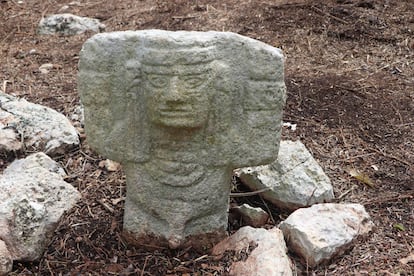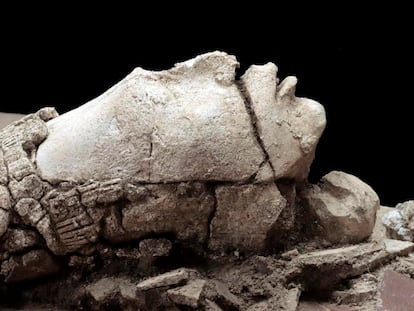Chichén Viejo, an ancient Mayan citadel surrounded by private land
The site south of Chichén Itzá will be inaugurated by Mexican President Andrés Manuel López amid controversy


Located about a mile from the main Chichén Itzá site, Chichén Viejo is an archaeological area with several ancient Mayan structures known as the Initial Series Group. Mexican President Andrés Manuel López Obrador is set to open the site to the public on September 2. However, visitors need to cross private land to access the area, which is not sitting well with the property owners.
During the government’s morning briefing on August 21, Diego Prieto Hernández, the director of Mexico’s National Institute of Anthropology and History (INAH), confirmed that Chichén Viejo must be accessed through private land. However, he gave his assurance that an alternate route would be offered to avoid trespassing on private property. The original trail to Chichén Viejo would have crossed private land near the structures known as ‘El Caracol’ and ‘Monjas.’
Mexico’s Reforma newspaper reported that on August 14, members of the Barbachano family (the property owners) denied entry to restoration workers, and placed private property signs around the area threatening trespassers with prosecution. In a rush to inaugurate Chichén Viejo on September 2, authorities opted to open a short access road that bypasses private property.

Archaeologists and security guards working in the area are now raising concerns about the new road, claiming that proper protocol wasn’t followed to identify and retrieve any archaeological remains from the road construction site. Photographs published by Reforma and Yucatán Ahora show heavy equipment laying the base material for the road.
In August, the INAH director announced the discovery of a 3-foot tall stone figure on the original trail to Chichén Viejo. This figure was likely used to support a ceremonial table and was adorned with jade beads, long earrings and carved stone bracelets. Prieto said that although these artifacts were found on private property, they belong to the nation and not the landowners according to Mexico’s law governing archaeological, artistic and historical monuments and sites.

The main Chichén Itzá Archaeological Zone will be closed to the public when the president inaugurates Chichén Viejo on September 2, and reopen the next day as usual. So far, no special activities or tours have been announced for the first tourists to Chichén Viejo.
Chichén Viejo housed the Mayan elites of Chichén Itzá and consists of living spaces, small buildings and various temples, including the Snail, Monkey, Phallus and Moon temples. The Initial Series Group has remained off-limits to visitors to Chichén Itzá, the legendary Mayan city declared a World Heritage Site by UNESCO in 1988, and one of the “New 7 Wonders of the World” in 2007. Chichén Itzá, which means, “At the mouth of the well of the Itza,” covers almost 10 square miles (25 square kilometers) and was the most powerful center of civilization in Mexico’s Yucatán Peninsula.
Chichén Viejo is part of a sweeping archaeological zone improvement program (PROMEZA) that complements the Mayan Train initiative. So far, 54,232 Mayan sites, including building ruins, pre-Hispanic plinths, cisterns, and 646 human graves have been identified along the Mayan Train routes.
#SalvamentoINAH | En las labores del trazo y prospección del camino que conducirá a Chichén Viejo o Serie inicial, fue hallada una escultura de un atlante cuyas dimensiones son 90 centímetros de altura por 45 centímetros de ancho. pic.twitter.com/eGNlfcAqXn
— INAH (@INAHmx) August 24, 2023
Sign up for our weekly newsletter to get more English-language news coverage from EL PAÍS USA Edition
Tu suscripción se está usando en otro dispositivo
¿Quieres añadir otro usuario a tu suscripción?
Si continúas leyendo en este dispositivo, no se podrá leer en el otro.
FlechaTu suscripción se está usando en otro dispositivo y solo puedes acceder a EL PAÍS desde un dispositivo a la vez.
Si quieres compartir tu cuenta, cambia tu suscripción a la modalidad Premium, así podrás añadir otro usuario. Cada uno accederá con su propia cuenta de email, lo que os permitirá personalizar vuestra experiencia en EL PAÍS.
¿Tienes una suscripción de empresa? Accede aquí para contratar más cuentas.
En el caso de no saber quién está usando tu cuenta, te recomendamos cambiar tu contraseña aquí.
Si decides continuar compartiendo tu cuenta, este mensaje se mostrará en tu dispositivo y en el de la otra persona que está usando tu cuenta de forma indefinida, afectando a tu experiencia de lectura. Puedes consultar aquí los términos y condiciones de la suscripción digital.
More information
Archived In
Últimas noticias
Sinaloa Cartel war is taking its toll on Los Chapitos
Venezuela hardens its ‘revolutionary state’ project amid pressure from Trump
Sydney Sweeney, the actress praised by Trump: ‘Women are up against what society wants them to be’
The Bolsonaro surname: An advantage or liability in Brazil’s 2026 presidential elections?
Most viewed
- Reinhard Genzel, Nobel laureate in physics: ‘One-minute videos will never give you the truth’
- Pablo Escobar’s hippos: A serious environmental problem, 40 years on
- Charles Dubouloz, mountaineering star, retires at 36 with a farewell tour inspired by Walter Bonatti
- Why we lost the habit of sleeping in two segments and how that changed our sense of time
- The fall of a prolific science journal exposes the billion-dollar profits of scientific publishing










































